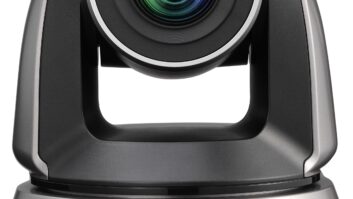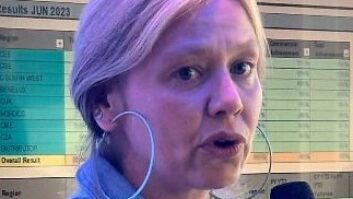Today, there is less – if any – technical difference between the cameras used for product launches, company presentations and conferences and those found in television studios or on the sets of high-end TV drama and feature films. It has been a logical progression, a convergence of technological features such as high definition, 4K resolution (and above), HDR (high dynamic range) and automation that has brought once disparate sector closer together.
While this was anticipated in many respects, what has been less expected is the rise of cameras previously regarded as being very much for one purpose. PTZ (pan tilt zoom) cameras were once found almost exclusively as part of closed circuit TV (CCTV) security installations. Now they are used routinely in corporate environments, as well as for broadcast and movie production. The humble webcam has had a parallel elevation and is now vital for hybrid working.
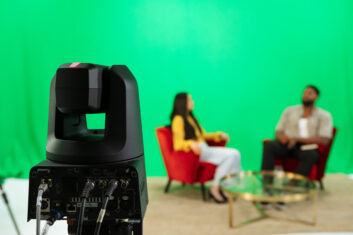 Leading camera manufacturers such as Sony, known for both its TV and cinematography models, began producing PTZ cameras in the last few years and are now seeing high demand for them for corporate AV. “We have a certain customer set for PTZ cameras,” comments Claire Lam, category head of network camera solutions at Sony Europe. “The corporate market is a big sector for them, especially in recent years during the pandemic with everyone remote or hybrid working. The growth rate in the corporate market is more than in other sectors, such as education.”
Leading camera manufacturers such as Sony, known for both its TV and cinematography models, began producing PTZ cameras in the last few years and are now seeing high demand for them for corporate AV. “We have a certain customer set for PTZ cameras,” comments Claire Lam, category head of network camera solutions at Sony Europe. “The corporate market is a big sector for them, especially in recent years during the pandemic with everyone remote or hybrid working. The growth rate in the corporate market is more than in other sectors, such as education.”
FULL FEATURES
Lam explains that the main use has been conference calls but post-pandemic it extended to also include live events. “People are now looking for full PTZ features,” she says. “Not only to be like a webcam but for the full mechanical/automatic pan tilt zoom with remote control to adjust the iris or the brightness and track who is speaking at a particular time. The most common application is remote live-streamed web conferencing but also live corporate events.”
Webcams were at one time a purely domestic technology, which continues through the ongoing reliance by many companies on remote video conferencing for some staff. But, as James Spencer, director of video solutions at Jabra, observes, what were previously ‘personal cameras’ are now also a key part of hybrid operations, including in-room meetings. “Our PanaCast 20 is a personal video camera but the hybrid working side is very much interlinked,” he says. “It is 4K, aluminium-bodied and you can carry it around with you. For hybrid working it also has picture-in-picture mode, which allows you to zoom in on something in the background but still have the speaker in an inset window.”
This, combined with an intelligent zoom for centring someone in a shot, makes for a more dynamic presence in the conferencing space, Spencer explains. “There is also lighting correction,” he says. “So if you are in a coffee shop and trying to do a call you can’t guarantee where you are going to sit but the camera will bring the light up to the correct level and everyone feels part of the same meeting.”
KEY TOOLS
The goal is ‘meeting equity’, where everyone on a call has the same experience whether they are in the office or at home. A key tool in achieving this for Jabra and other webcam manufacturers is artificial intelligence (AI). Poly – now part of HP (Hewlett Packard) – is employing the power of AI and machine learning (ML) through features such as Director AI delivering real-time automatic transitions, framing and tracking.
“Most customers are looking for simplicity and automation,” says David Danto, director of unified communications (UC), strategy and research at Poly/HP. “They want to equip their conference rooms and collaboration spaces with devices that are intelligent enough to frame and focus participants without the need for any remote control or complex touch panels.” Danto sees new electronic PTZ (ePTZ) functionality within models such as the [R30 or E70] as not only offering greater flexibility…”
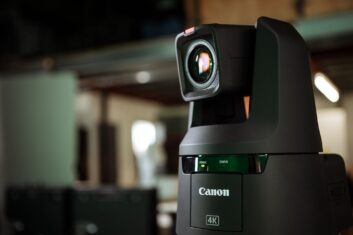 Acknowledging that the new breed of professional webcams are vying with PTZ cameras for a slice of the corporate AV market, Danto sees new electronic PTZ (ePTZ) functionality within models such as the R30 or E70 as not only offering greater flexibility but also helping keep the camera more in the background. “Mechanical PTZ cameras give meeting participants the creeps as they noisily move around,” he says. “EPTZ cameras are ideal as they noiselessly get shots with no moving parts. Multi-element room cameras and near-future camera arrays will surround a space with shots that intelligent AI and ML will use to track and frame the right people.”
Acknowledging that the new breed of professional webcams are vying with PTZ cameras for a slice of the corporate AV market, Danto sees new electronic PTZ (ePTZ) functionality within models such as the R30 or E70 as not only offering greater flexibility but also helping keep the camera more in the background. “Mechanical PTZ cameras give meeting participants the creeps as they noisily move around,” he says. “EPTZ cameras are ideal as they noiselessly get shots with no moving parts. Multi-element room cameras and near-future camera arrays will surround a space with shots that intelligent AI and ML will use to track and frame the right people.”
Conventional, broadcast-style cameras continue to feature in corporate presentations and product launches but, as Mat Recardo, technical services supervisor at UK hire and sales company CVP, observes, small static camera heads and, increasingly, PTZ are making inroads into these areas as well. “PTZ is useful for anyone leaning into the walk-and-talk stage event,” he says, “although operator-run cameras on tripods or shoulders are still superior when it comes to tracking and getting that ‘TED Talk’ look.”
Recardo’s CVP colleague, e-commerce manager Glenn Lightbody, comments that there is currently “high demand” for PTZ technology, with one of the attractions being single operator has more control and is able to run a production without the need for multiple camera operators. He adds that a key technology in corporate, as in broadcast, is NDI (Network Device Interface), which enables everything to be controlled and networked down a single cable.
The quality and look of cameras have also become priorities for corporate users in the last few years. Which explains why some conference and meeting installations have deployed DSLR (digital single lens reflex) and new generation mirrorless cameras in place of webcams. Both feature live streaming capabilities and can be adapted for conference call work through software interfaces such as Elgato 4K Cam Link, Imaging Edge for Sony cameras and Canon EOS Webcam Utility, as well as a clean HDMI connection.
While Panasonic offers DSLR cameras, Guilhem Krier, head of new business & market development at Panasonic Business Europe, explains these are aimed primarily at the production market, which demands something more filmic, while corporate AV tends towards the traditional video look with its long depth of field. “Corporate is using PTZ more and more but traditional camcorders as well,” he says. “Also what is important in this market is to be able to automate things so the camera can be managed remotely without dedicated staff.”
 Krier agrees that while PTZ cameras were available for corporate 20 years ago, they were not much used, for a number of reasons. “The demand for PTZ was not big back then because the quality was not very high,” he says. “It was not considered as a good enough product, particularly for broadcast, and the need for automation was not great. But as quality increased and the demand for automation increased, PTZ cameras have become very much in demand for this market and Covid gave them a big push.”
Krier agrees that while PTZ cameras were available for corporate 20 years ago, they were not much used, for a number of reasons. “The demand for PTZ was not big back then because the quality was not very high,” he says. “It was not considered as a good enough product, particularly for broadcast, and the need for automation was not great. But as quality increased and the demand for automation increased, PTZ cameras have become very much in demand for this market and Covid gave them a big push.”
LATE ARRIVAL
More camera manufacturers are now producing PTZ cameras, with Canon relatively late to the party in launching its first models – the indoor N300 and N500, outdoor X500 and a controller – in 2021. Graham Payne, product business developer for Canon’s ISB business, says this launch was “well considered” and something the company had been working on for some time. “It was important that we understood the market before coming into it,” he says. “Our PTZ cameras utilise technologies from our camcorder range, such as the sensor and auto focus, which enables our stills and video products to fit seamlessly into an existing ecosystem.”
Blackmagic Design (BMD) also has what technical sales manager Darren Gosney describes as “end-to-end ecosystems”, going from its full size and DSLR-style digital cinematography cameras through ATEM live production switchers to the DaVinci Resolve post-production software suite. BMD does not currently offer PTZ cameras and, says Gosney, has nothing in development as yet, but is still targeting corporate AV. “We work in a whole realm of industries across the AV space, from installation companies building small studios, whether that’s for presentations to clients or communicating with the staff, to presentation spaces,” he says.
 “We have cameras that can be used for that but also products that sit alongside, like the Web Presenter box, which will enable a higher-end camera to be seen as a webcam. People want the higher quality but also to integrate it with their workflows, plugging into any conferencing or online platform, from Zoom and Skype to YouTube and Facebook. That way they get a polished images with good colour fidelity and dynamic range.”
“We have cameras that can be used for that but also products that sit alongside, like the Web Presenter box, which will enable a higher-end camera to be seen as a webcam. People want the higher quality but also to integrate it with their workflows, plugging into any conferencing or online platform, from Zoom and Skype to YouTube and Facebook. That way they get a polished images with good colour fidelity and dynamic range.”
For a device with a history of over 130 years, the moving picture camera shows no sign of slowing up in its development. “We’re seeing a lot of progression,” agrees Garry Cox, education and corporate solutions product manager at Sony Professional Solutions Europe. “Our new cameras feature AI built in, with analytics and video processing in real time, plus auto-framing and tracking. Traditionally there would have been a separate box or server to do that but we can bring it directly into the camera itself. There are also many different streaming protocols that can be accommodated, like NDI, SRT and RTMP, which makes the cameras more generally available for different applications.”
What this will mean ultimately, Cox concludes, is that rather than having a dedicated camera for a particular function and another for a different function, everything can be brought together within a single camera. Even with a multi-purpose approach, it is unlikely that the evolution of cameras will slow or end. After all, the people using them will always find something else they want to do with them.
